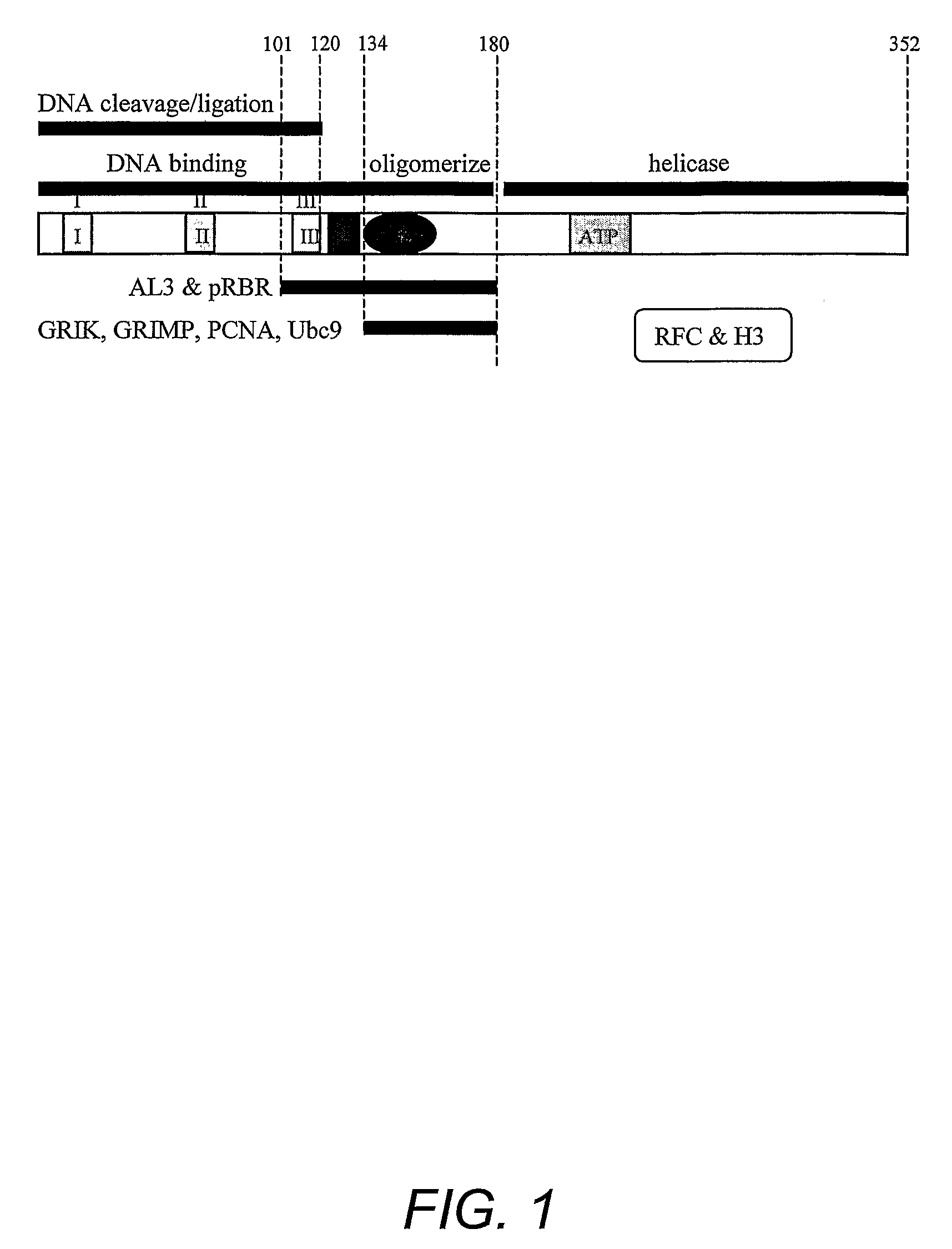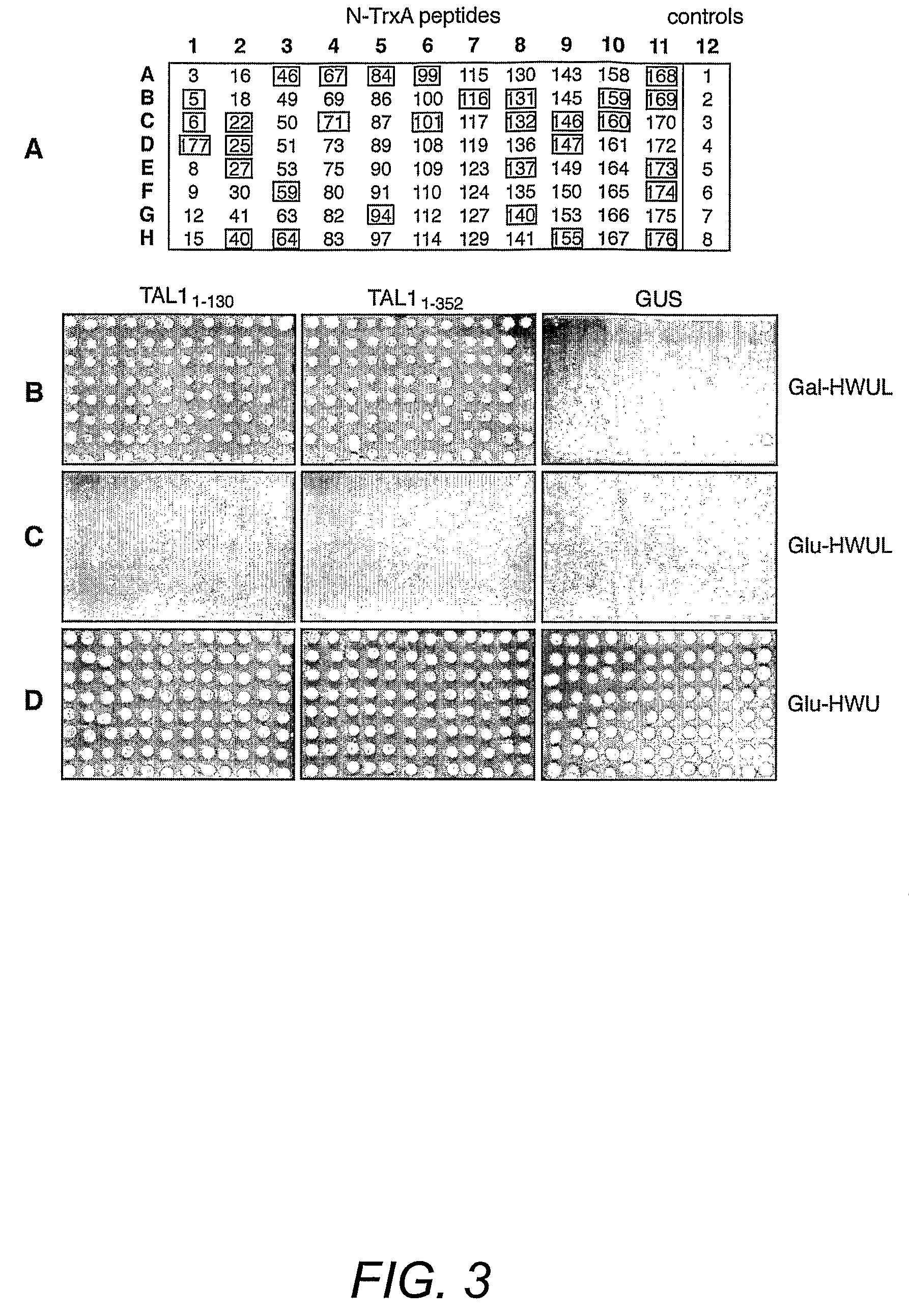Peptide aptamers that bind to the rep proteins of ssDNA viruses
a technology of ssdna virus and aptamer, which is applied in the field of peptide aptamer that bind to the rep proteins of ssdna viruses, can solve the problems of severe disease problems in plants and animals, significant disease losses in livestock and poultry,
- Summary
- Abstract
- Description
- Claims
- Application Information
AI Technical Summary
Benefits of technology
Problems solved by technology
Method used
Image
Examples
example 1
Viruses
[0143]Geminivirus Rep proteins have been studied extensively, and many of the assays for studying this protein are well-established in the art. Consequently, geminiviruses were used to test the capacity of aptamers to interfere with ssDNA virus replication and infection in eukaryotes. The tomato golden mosaic virus (TGMV) and cabbage leaf curl virus (CbLCV) were primarily studied. TGMV is a bipartite geminivirus that infects solanaceous species and encodes a typical Rep protein. CbLCV has a bipartite genome and is a severe pathogen in brassica. CbLCV is representative of a small group of dicot-infecting geminiviruses that encode an atypical Rep protein. Other viruses such as ACMV, BCTV, EACMV, MSV, ToMoV and TYLCV may also be useful in the analysis of selected aptamers. For example, TYLCV is a monopartite geminivirus that causes significant losses in tomato crops through out the world. Genomic clones as well as replication and infectivity assays are well established for these...
example 2
Materials and Methods
A. Yeast Plasmids.
[0144]The bait and prey plasmids used in this study are listed in Table 2. pNSB1118, the bait plasmid for full-length TGMV AL1 (TAL11-352), was generated by cloning a 1.2-Kb fragment with NdeI (trimmed) and BamHI ends from pNSB736 (Orozco et al. (2000) J. Biol. Chem. 275:6114-6122) into pEG202 (Golemis and Brent (1992) Mol. Cell. Biol. 12:3006-3014) with BamHI and EcoRI (repaired) ends. The same fragment was also ligated into pHybLex / Zeo (Invitrogen) digested with PvuII and BamHI to create pNSB1089. The TAL11-352 coding sequence from pNSB1089 was introduced into pYESTrp2 (Invitrogen) as a SacI / XhoI fragment to give the prey plasmid pNSB970. The bait plasmid for truncated TAL11-130 (pNSB1162) was generated in two steps. First, an 895-bp EcoRI / BamHI fragment from pNSB603 (Orozco et al. (2000) J. Biol. Chem. 275:6114-6122) was ligated into the same sites of pNSB1118 to create pNSB1153. Then, pNSB1153 was digested with NotI, repaired with E. coli D...
example 3
[0154]Geminivirus replication proteins contain several conserved motifs that are essential for function. To develop new approaches to study and modulate these proteins, the pJM-1 library for interacting peptides using the well-characterized TGMV replication protein designated here as TAL1 was screened. The pJM-1 library encodes E. coli thioredoxin (TrxA) with 2.9×109 random 20-mer peptides in its active site (Colas et al. (1996) Nature 380:548-550). The TrxA-peptides are fused to the SV40 nuclear localization signal, the E. coli B42 activation domain (AD) and the hemagglutinin epitope tag and are expressed from the yeast Gal1 promoter (Colas et al. (1996) Nature 380:548-550). For the screens, two types of TAL1 bait plasmids (FIG. 2A) were constructed. TAL11-352 encodes the full-length TAL1 protein fused to the E. coli LexA DNA binding domain (DBD). TAL11-130 specifies a LexA DBD fusion with the first 130 amino acids of TAL1, which includes the conserved ...
PUM
| Property | Measurement | Unit |
|---|---|---|
| diameters | aaaaa | aaaaa |
| diameter | aaaaa | aaaaa |
| pH | aaaaa | aaaaa |
Abstract
Description
Claims
Application Information
 Login to View More
Login to View More - R&D
- Intellectual Property
- Life Sciences
- Materials
- Tech Scout
- Unparalleled Data Quality
- Higher Quality Content
- 60% Fewer Hallucinations
Browse by: Latest US Patents, China's latest patents, Technical Efficacy Thesaurus, Application Domain, Technology Topic, Popular Technical Reports.
© 2025 PatSnap. All rights reserved.Legal|Privacy policy|Modern Slavery Act Transparency Statement|Sitemap|About US| Contact US: help@patsnap.com



